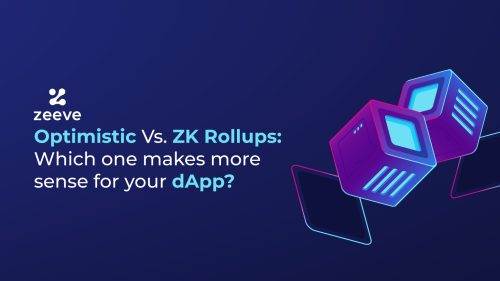
Optimistic Vs. ZK Rollups: Which one makes more sense for your dApp?
Rollups have emerged as a key player in the narrative for businesses and developers seeking scalable solutions. Initially, the buzz was all about Optimistic rollups, with ZK rollups often deemed great in theory but distant in practical application. Even Vitalik Buterin echoed this sentiment. However, ZK rollups have transitioned from theory to reality much sooner than anticipated, and with the advent of the latest zkEVMs, their adoption has been soaring. Now, apparently this raises an inevitable question: Which one is better? Optimistic Rollups or Zero Knowledge Rollups?
While the ultimate choice may boil down to ‘It depends on your application,’ it’s crucial to weigh certain factors to discern what your application truly requires. In this article, we’ll delve into key considerations to guide you towards an informed decision about the rollup technology that best aligns with your needs.
How Optimistic Rollups Work: The Mechanism
As the name suggests, Optimistic rollups are optimistic about the state of every transaction by default to increase efficiency. Hence, they don’t publish validity proofs for off-chain transactions when submitting batches to the mainnet as calldata.
Instead, what they do is they give a ‘challenge period’ for anyone monitoring the rollup to submit a fraud-proof within that time window. If the fraud-proof is found to be true, the roll-up sequencer nodes re-execute the wrong transactions and update the block.
The sequencer who has added the wrongly executed transaction in the block receives a penalty. But if the blocks remain unchallenged, then after the dispute window is over, transactions are accepted on Ethereum.
Read more on Optimistic Rollups and how low-cost and scalable applications are built using it.
Two of the most popular Optimistic rollup public chains are Optimism and Arbitrum. In Optimism, the fraud-proof mechanism is under development, so the user needs to trust the block proposer to submit correct L1 state roots. In Arbitrum, fraud-proof works, but challenges can only be initiated by a member of the whitelisted validator set.
A recap of ZK Rollup working mechanism
Zero-knowledge(ZK) rollups are an L2 scaling solution where the sequencer nodes publish the summary of state changes along with the validity proofs of executed transactions to L1 smart contracts instead of posting the actual transaction details, unlike OP rollups. This is why it’s called Zero-knowledge.
The submitted validity proofs are significantly smaller than the actual transaction data and come as zkSNARK or zkSTARK. Verifying them is quicker and cheaper. These validity proofs by the zkRollups nodes for every block are a cryptographic assurance that the state roots proposed by the sequencers result from executing those given batches of transactions. This allows anyone to reconstruct the rollup’s state independently.
In zkRollup, users can withdraw their funds immediately on L1 once the zkRollup contract verifies the validity proof.
Learn more on Scaling your dApps with the power of zkRollups
Two of the most popular zkRollup public chains currently are Polygon zkEVM and zkSync Era. Both are a Stage0 rollup and could be used for universal use cases. While Polygon zkEVM uses a zkSNARK to ensure state correctness, the zkSync Era uses PLONKs for state validation.
What to consider before choosing the right L2 Rollup? A detailed breakdown of OP & ZK Rollups
Now that we know the basics of Optimistic and Zero-knowledge rollups let’s jump into a detailed analysis of multiple parameters one needs to consider before one chooses what kind of rollups make the most sense for their application.
- Security and Risk
In Optimistic rollups, the mechanism of fraud-proofs and economic incentives to the sequencers ensures that only valid transactions are added to the blocks. With at least one honest validator, users are guaranteed that the correct rollup state root will eventually be published on L1. This is because once a node challenges the state root, the transaction is re-executed on Ethereum. But if all the sequencer nodes are corrupt, funds can be stolen simply by not initiating any challenge.
But for zkRollups, the dependence on honest sequencers is not there as the validity proofs are submitted along with each batch of transactions. A malicious operator must find and exploit a soundness bug in the audited proof system to forge a validity proof and steal funds. This is a near-impossible task, and that’s the big difference between a permissioned fraud-proof and a permissioned ZKP.
But one negative is that, at the moment, most of the sequencers are centralized as computing such sophisticated ZK proofs decentrally could come costly. This is a concern from the aspects of decentralization because transaction ordering and execution are handled by a handful of nodes. This is changing, though, with shared and direct decentralized sequencers coming into the picture.
As rollups are modular in nature, you could choose each layer by analyzing your critical needs.

- Transaction Finality and Transaction Confirmation
Optimistic rollups increase transaction throughput with better transaction processing speed and faster confirmations. In Optimistic rollups, a transaction is considered confirmed once it’s included in a rollup block. However, this confirmation does not immediately equate to finality because of the challenge window(around a week). Finality is only achieved after this dispute period ends without challenges. So, the confirmation is achieved on the rollup chain, and the finality is achieved in the L1 after a period of a week. The withdrawal of assets is possible only after this time period, BUT you can use these assets on the L2 chain for further transactions as the new state is already acknowledged there. This is significant and makes it appealing for a range of use cases in DeFi, trading or similar activities.
For zkRollups, the transaction finality is faster. Hence, assets can be withdrawn on L1 without waiting for weeks. But the transaction confirmation is relatively slower in the zkRollup chain (L2) because of the time taken to batch transactions, generate zero-knowledge proofs, and submit this data to L1. However, once the proof is generated and submitted to the Ethereum mainnet, the transactions are considered final immediately upon confirmation on Ethereum, as there’s cryptographic certainty about their validity.
- Transaction Cost
Optimistic Rollups typically have lower computational requirements compared to ZK Rollups, as they don’t need complex cryptographic proofs for transaction validation. This aspect helps in reducing the computation costs. However, they incur higher costs due to their way of interaction with the Ethereum mainnet. Since Optimistic Rollups post all transaction data on Layer 1 and require a dispute period to ensure transaction validity, this can increase the costs associated with transaction processing. Despite this, their approach of publishing minimal data on Ethereum and avoiding proof requirements for transactions unless specifically challenged, coupled with support from protocols like EIP-4844, contributes to cost efficiency in Optimistic Rollups.
ZK Rollups, on the other hand, involve more off-chain computation for generating cryptographic proofs, which traditionally required significant computational resources and potentially specialized hardware. However, recent advancements in ZK Rollups have been focusing on improving the computation efficiency while reducing costs. Innovations such as recursive proof composition and batching proofs have been developed to decrease the number of necessary elliptic curve operations, polynomial commitment schemes, etc- thus reducing the computational burden. Moreover, the evolution of ZK Rollup platforms like zkSync Era and Polygon zkEVM highlights advancements in data compression and efficiency. These platforms are working towards reducing computational requirements, a key factor in making ZK Rollups more cost-effective and accessible for broader use.
- EVM Compatibility
For Optimistic Rollups, a key advantage was their direct compatibility with the Ethereum Virtual Machine (EVM). Being EVM-compatible means they support the EVM at the bytecode level. This compatibility offers significant benefits for developers, as it allows the migration of existing Ethereum smart contracts to Optimistic Rollup chains with minimal code modifications, saving significant development time. This enables the use of Ethereum’s extensive infrastructure, including programming languages, libraries, testing tools, and deployment systems. This established tooling has undergone extensive audits and improvements, making the development process more reliable and easier to adapt to, thereby lowering entry barriers.
On the other side, ZK Rollups historically faced challenges with EVM compatibility, but recent advancements in zkEVMs have marked a significant shift. These modern ZK Rollups are not just EVM-compatible but aim for EVM equivalence, ensuring that applications, tools, and infrastructure built on Ethereum can seamlessly port over with little to no changes. Polygon zkEVM, for example, focuses on achieving EVM Equivalence, which facilitates immediate and efficient integration of Ethereum-based applications and tools, ensuring compatibility and ease of use from day one.This advancement significantly enhances the accessibility and applicability of ZK rollups, making them easily integrable within the broader Ethereum ecosystem.
- Privacy
In Optimistic Rollups, privacy is relatively limited. Transactions and signatures are visible on the rollup layer and subsequently on the main Ethereum chain. This visibility allows the transactions to be traced back to user addresses. The inherent transparency in Optimistic Rollups, necessary for their security model, thus compromises privacy to some extent.
ZK Rollups on the other hand makes the user’s privacy better by utilizing zero-knowledge proofs(ZKPs). These proofs enable the concealment of transaction details, ensuring that only the involved parties are aware of the transaction specifics. The broader public, including those operating nodes, cannot link the transactions to specific user addresses. While more private than Optimistic Rollups, it’s important to recognize that privacy levels in ZK Rollups can vary. Some ZK Rollup solutions may offer less privacy in certain configurations, especially in public implementations where transaction visibility is necessary for operational transparency. Nonetheless, for applications where privacy is a priority, ZK Rollups generally offer a more suitable solution compared to Optimistic Rollups.
A TL, DR:
| parameters | Optimistic Rollups | ZK Rollups |
| Mechanism | Optimistic about the state of every transaction. Rely on a challenge period for fraud-proof. | Publish summary of state changes with validity proofs. No need for actual transaction details, hence “Zero-knowledge”. |
| Cost | Lower computational requirements; higher costs due to interaction with Ethereum mainnet. Support from protocols like EIP-4844 helps in cost efficiency. | Higher off-chain computation for generating cryptographic proofs. Recent advances have improved efficiency and reduced costs. |
| Security | Fraud-proofs and economic incentives ensure valid transactions. Reliant on having at least one honest validator. | Relies on cryptographic validity proofs for each transaction batch, reducing dependence on honest sequencers. Nearly impossible to forge proofs. |
| Finality | Faster confirmations but finality achieved only after the dispute period (about a week). | Faster finality, as transactions are immediately final upon confirmation on Ethereum. Slower transaction confirmation on L2. |
| EVM Compatibility | Direct compatibility with EVM, allowing easy migration of existing Ethereum smart contracts with minimal modifications. | Historically faced challenges, but recent zkEVMs are aiming for EVM equivalence, making integration of Ethereum-based applications more seamless. |
| Privacy | Limited privacy; transactions and signatures visible on rollup layer and Ethereum chain. | Enhances privacy using zero-knowledge proofs that conceal transaction details, making them more private than Optimistic Rollups. |
Launch your Optimistic & zkRollups with Zeeve
If you’re already sold on using Rollups for your apps, your next move is picking the best rollup solution. Like we talked about, there are public Rollup chains such as Optimism, Arbitrum, Polygon zkEVM, and zkSync Era, which offer Optimistic and ZK options. Also, there are tools like Superchains from OP Stack, Hyperchains from zkStack, and Polygon CDK chains that let you make your own specific OP and ZK Rollup blockchains. The right scaling solution depends on what your dApp needs in terms of scalability, customization, and flexibility. No matter which solution you lean towards for your app, Zeeve can hook you up with the right nodes and all the network setup you need.
You can get your hands on public mainnet nodes like Optimism, Arbitrum, Polygon zkEVM, and zkSync Era, and also tap into OP stack, Polygon CDK, and zkSync rollups with an easy, automated, no-code setup dashboard. Plus, Zeeve makes it a breeze to add on extra stuff for your zkRollup chains, like block explorers, faucets, and data indexers, all through our Rollups-as-a-service (RaaS). And all this comes with a rock-solid 99.9% uptime promise and top-notch Enterprise SLA.
Got more questions about picking the best ZK scaling solution for your dApp? Our Zeeve pros are here to help. Book a chat with us today and see how Zeeve can make setting up your zkRollup a smooth ride.


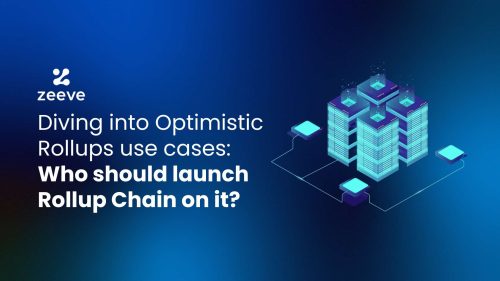
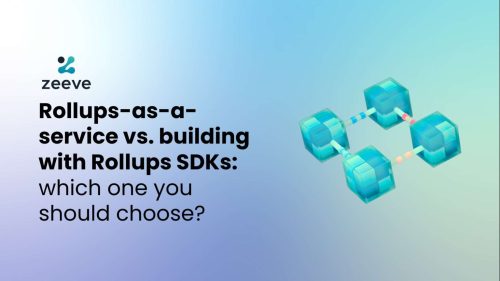
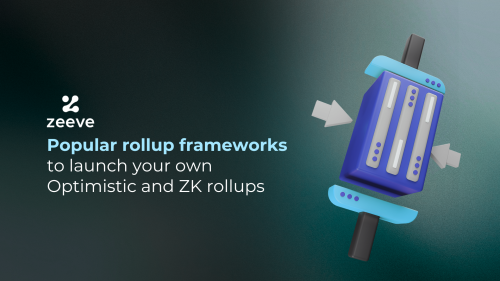

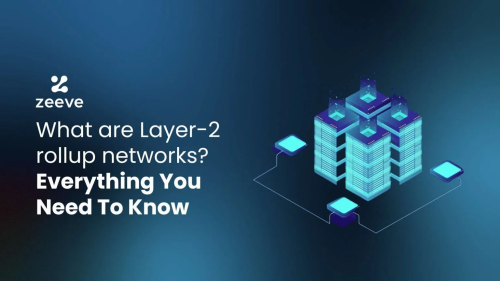
Responses